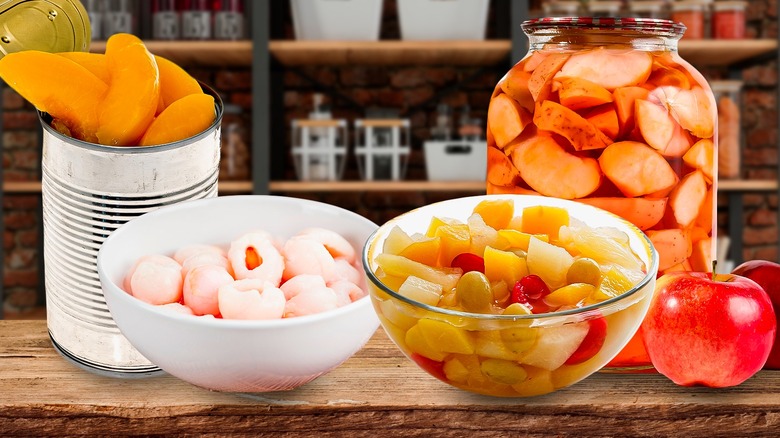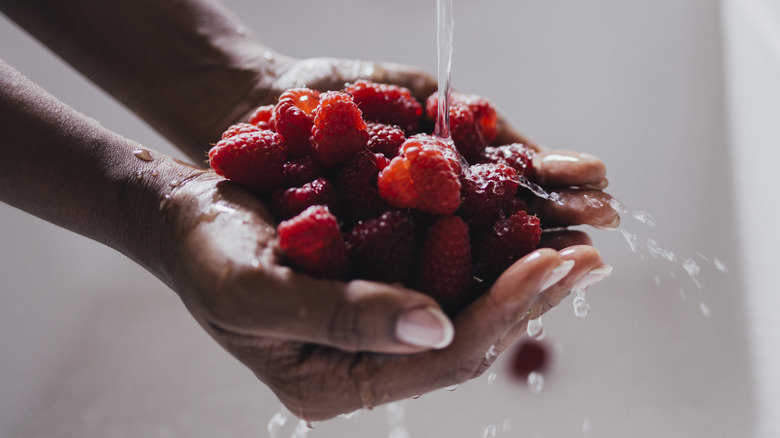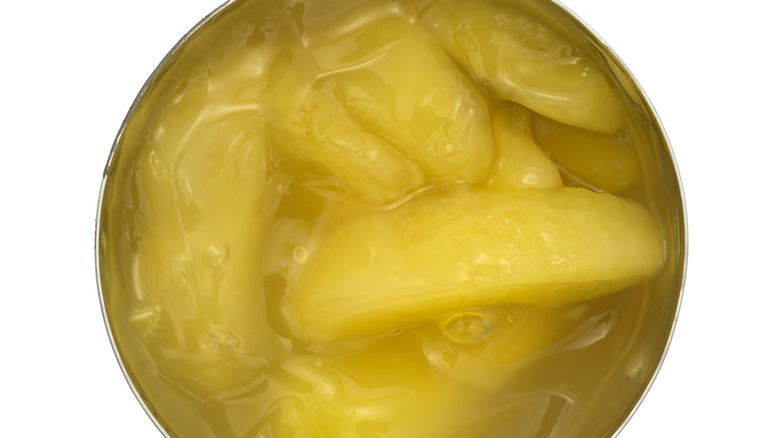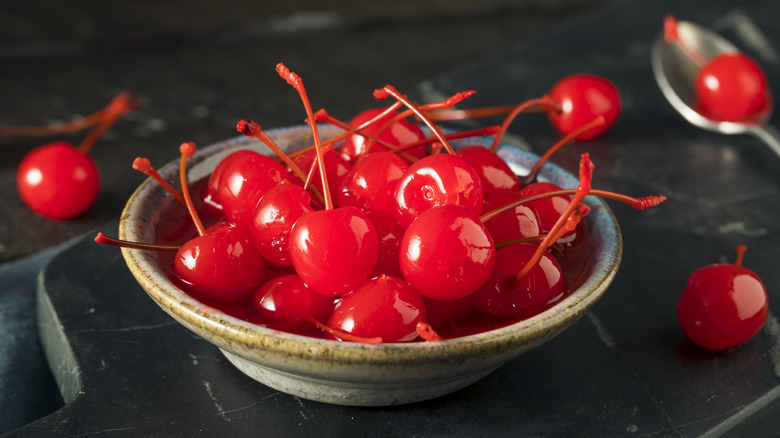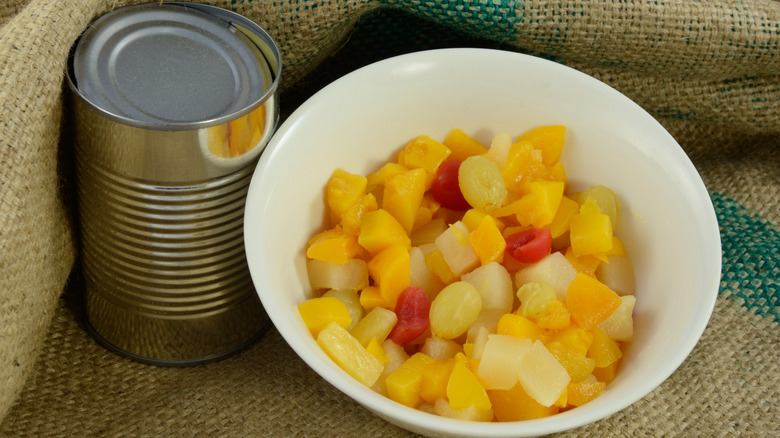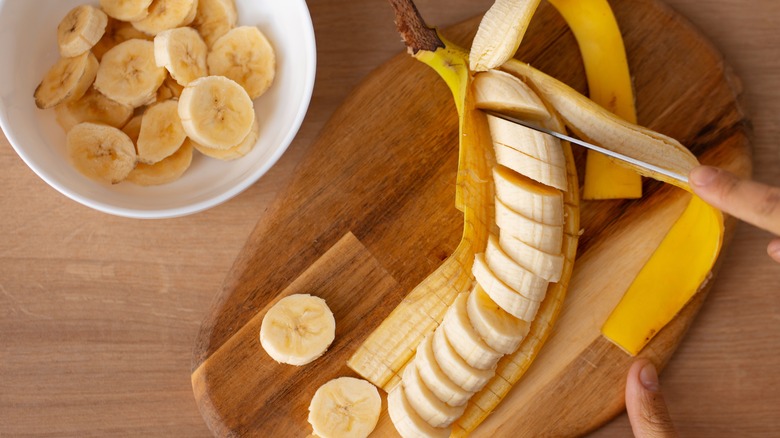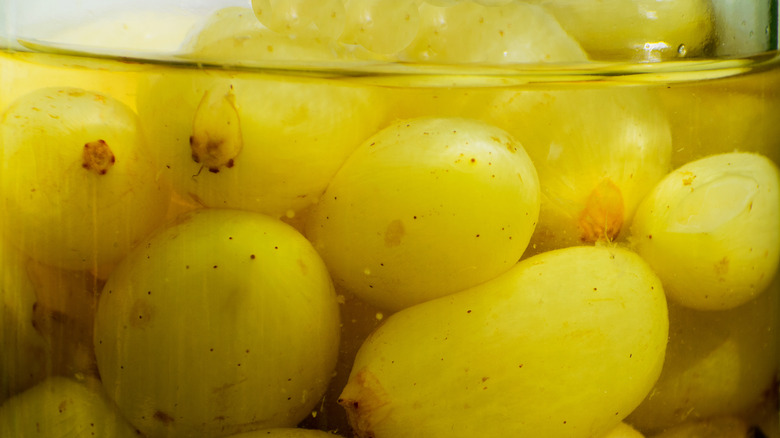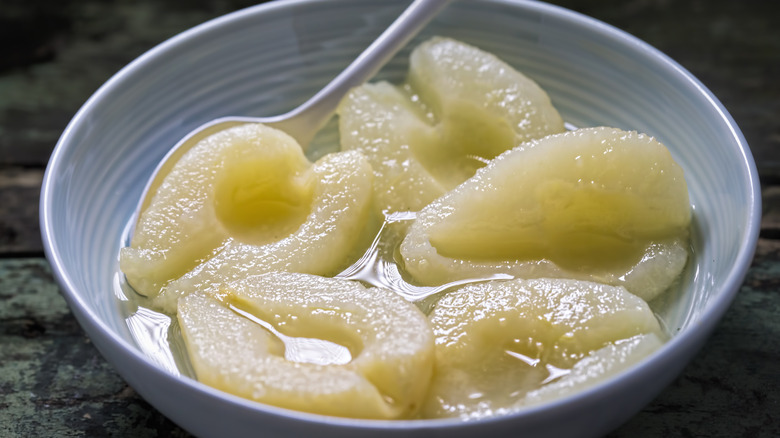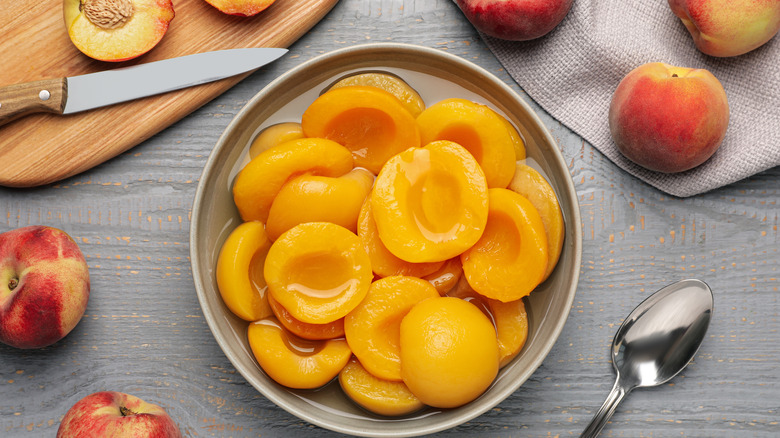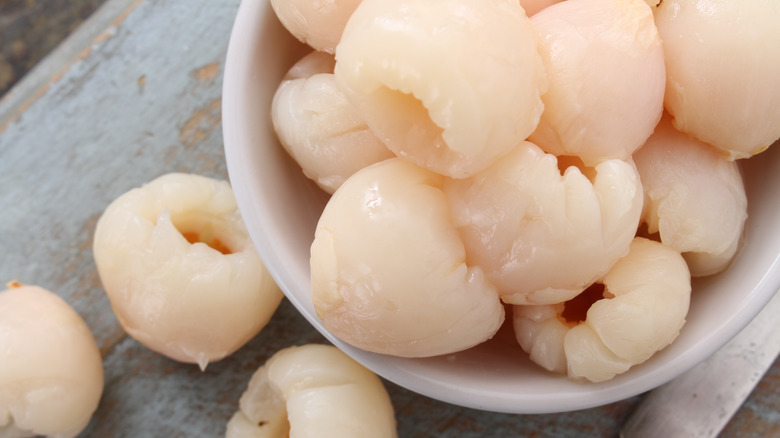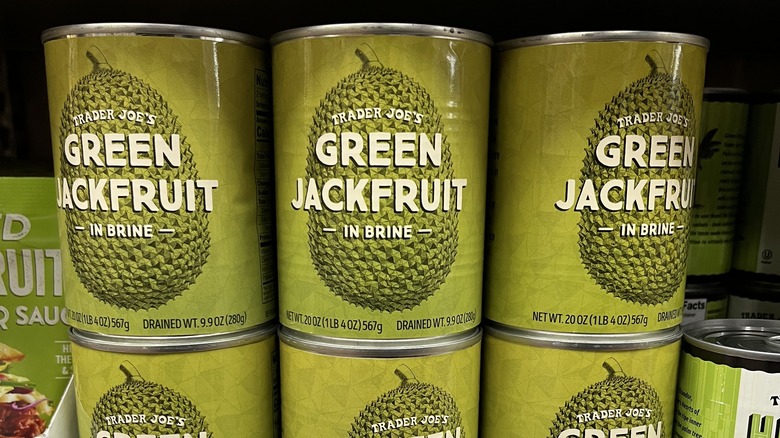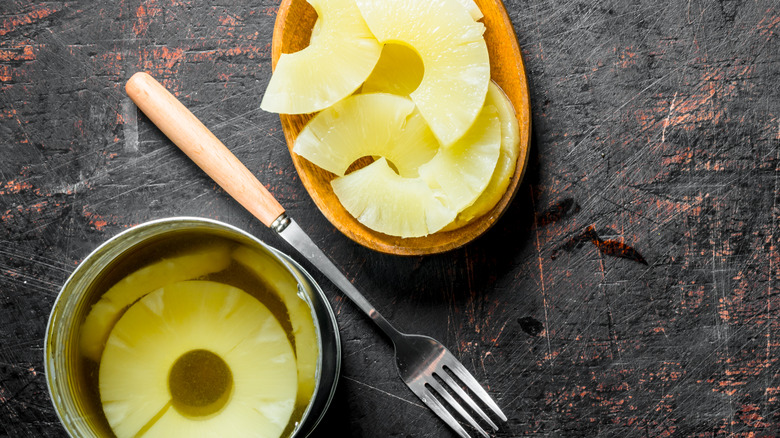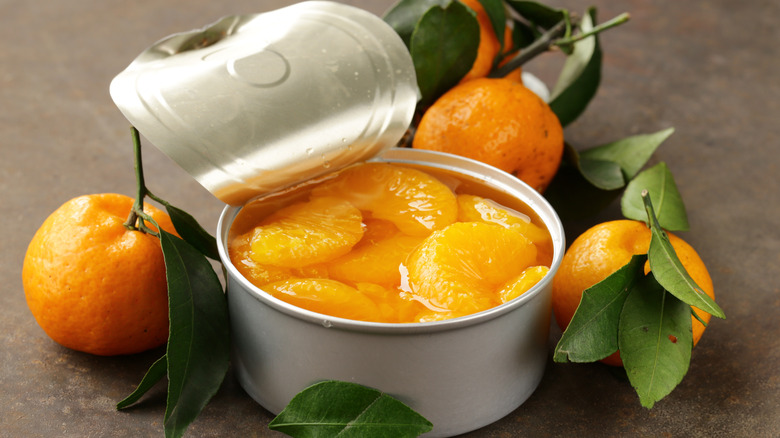6 Best And 6 Worst Canned Fruits To Buy At The Grocery Store
Since the beginning of time, societies have developed methods to preserve foods beyond the shorter lifespan they have when fresh. Some of these methods include fermenting, pickling, salting, curing, smoking, and drying, but since the turn of the 18th century, food industries started canning, making it possible to buy foods that could last through shortages, wars, and through less fruitful seasons. Canned foods have become commonplace and exist in many different varieties, from cooked foods to fruits and vegetables.
Sadly, canned food doesn't always have the best reputation and tends to be looked down on as a lesser version of the real thing. However, not all canned foods are equal, and there are plenty of options that allow you to have certain items in a more convenient way. Having gone through the steps of washing, peeling, seeding, or precooking, canned products can save you time and help you enjoy certain foods more often, and throughout the year.
Canned foods, especially fruit, are often canned at the time of their highest ripeness and therefore are their tastiest. Another benefit is that canned foods are also oftentimes more affordable, and therefore more accessible to people than fresh produce. Fruit is one of the temperamental foods that sometimes don't fair well with canning. As a home cook, food writer, and fruit lover, I've tried numerous canned fruit products. Here's a list of some of the worst and best canned fruits on the market.
Worst: Berries
We've all experienced berries when they're not yet ripe — the sourness can be really striking, or with some berries, you simply get a lack of taste. But we endure because there is such a high payoff when you eat perfectly ripe berries. There are few experiences as pleasing as biting into plump, sweet, and flavorful blueberries, blackberries, raspberries, and more. Yet, berries are some of the most difficult fruits to keep in their original form through preservation, as they tend to lose their body and texture. While they may be canned at their most ripe, canned berries are among some of the most disappointing of canned fruits. They become more like a compote than fresh berries.
They do serve the purpose of being a good option for baking pies or making things like cake filling. But when it comes to preserving berries, frozen berries are a better choice and have even more options than canned berries. You can make quick ice cream with them, whip up smoothies, defrost them, eat them whole, and use them for baking. Frozen berries are also the better option when it comes to getting all the nutritional benefits, as freezing preserves their nutritional value and doesn't come with added sugar from canning syrups or juices.
Worst: Apples
Apples make the list for worst canned fruit because they're really only useful for making apple pie, or other baked goods that contain soft apple filling. Apples are one of the most ubiquitous fruits in many countries and are usually available all year round. In the U.S., 95% of all apples are homegrown, making them a very accessible fruit (via U.S. Apple Association). They're also not considered to be an expensive fruit, relatively, so there's really no reason to buy canned apples over fresh unless it's for baking or making apple sauce.
Fresh apples are so easy to acquire, affordable, and can be eaten with no preparation — just wash and it's ready to eat! The crunch of your teeth biting into apple flesh is one of the best things about it, and canned apples simply don't match that — they are usually more mushy and lack flavor. For a fruit that already has quite a mild flavor, canning doesn't allow for the flavor of apples to shine. Plus, canned apples are almost always peeled, which means you're not getting the numerous health benefits that apple peels have, like vitamins A, C, and K.
Worst: Maraschino cherries
The original maraschino cherries were a way of preserving sour Morello cherries in Croatia, using a liquor made from them, but the version that we commonly find in grocery stores today is something completely different. While you might love to savor the maraschino cherry in your cocktail, or on top of an ice cream sundae, the bad news is maraschino cherries are some of the worst canned fruits you can eat.
You may have wondered how maraschino cherries get their vibrant color. The answer is that they've been stripped of all their natural flavor and color by being soaked in calcium chloride and sulfur dioxide, which is, in other words, bleaching. They are then dyed artificially and drenched in high-fructose corn syrup. They are more like candy than the original fruit, and while that might not be a problem for its use as a fun garnish, it's an obvious choice for worst canned fruit for the purpose of actually eating cherries.
Worst: Fruit cocktail
Fruit cocktail has their lovers and haters, and we're not trying to tell you that you're right or wrong, especially if you enjoyed it in your childhood, but when compared with other canned fruits, there are simply better options out there. Additionally, it's undeniable that making your own fruit salad from whatever fruits you have available results in a way tastier and more nutritious dish.
While it does require a bit of time in the kitchen prepping fruit for a fresh fruit salad, the benefits are that you can choose which fruit you like best, and skip the ones you don't. You can also change the fruit depending on what's in season, making it much more exciting and adaptable than the consistent taste and experience of a can of fruit cocktail. Plus, if you're serving it to a large family or guests, it's not necessarily always more affordable to buy canned fruit cocktails, as you'll have to buy many cans.
Worst: Bananas
Bananas are one of the most loved fruits in the world, and the same can be said for the U.S., according to Statista, which found that they were the most consumed fruit in the country in 2022. While they might be tropical fruits, the high demand for bananas means they are available to buy year-round, so there isn't a very good reason why you'd reach for the canned variety. Fresh bananas are not only very easy to eat and enjoy since all it takes is removing the banana peel, but they also go soft quite quickly, meaning that if you wanted to use them for baking banana bread or banana cream pie, it's actually still convenient to use fresh bananas.
As an already mushy fruit, canned bananas tend to be even more mushy. Additionally, they can be a really volatile fruit to can, so it's not even a common fruit to find in the grocery store. All in all, it's hard to make a case for canned bananas.
Worst: Grapes
The arguments for why canned grapes have made our "worst" list are very similar to why canned bananas are a no-go: Fresh grapes are not hard to find. Grapes are not a particularly seasonal fruit, meaning you can usually find them throughout the year, without them needing to be imported or grown out of season. They also don't require any special preparations — they are ready to eat.
Canned grapes are often quite soft and bruised, not holding their integrity, making them a really different eating experience compared to fresh grapes. They also don't have the crispness of fresh grapes because they are usually peeled. If you prefer eating grapes with no skin, then this might be a good option for you, but this isn't a common preference. Canned grapes might be useful in compotes, but there are not many other uses for them beyond that. Plus, canned grapes are not so easy to find as they're not a particularly popular ingredient.
Best: Pears
Canned pears are one of the best fruits for canning, and this is because they soften and become similar to the texture of poached pears, a beloved dessert. If you've ever made poached pears, you know how long it takes, and how you have to make sure they don't overcook and become too soft. While with other canned fruits softness can be off-putting, with pears, the softness isn't mushy, but rather they're the perfect tenderness: soft enough to have a spoon go through them with ease, but not so soft that they don't hold their shape.
They go really well with desserts, yogurt, cakes, and simply on their own too. They make for an incredible shortcut for things like pear cobbler or pear crumble. They don't lose their flavor or their graininess, both of which are things people love about pears. They are also a canned fruit aisle staple, and always easy to find at any store. Another benefit is that they're really easy to digest and often recommended to people who have stomach problems, like diarrhea.
Best: Peaches
Peaches are a popular canned fruit and for good reason. While peaches are well-loved, they have a relatively short time in season. This is the same for many large stone fruits, like nectarines and apricots. Not only are they extremely seasonal, but they also have a short shelf life. This creates incentives to can them, and for people to buy them canned at other times of the year. Their seasonality means that a lot of fresh stone fruits tend to be a little bit pricier than other fruits, making canned peaches a more affordable option. Another added bonus for folks who struggle with fuzzy peach skin is that you can avoid them altogether with canned peaches since they're peeled.
Frozen peaches don't hold up quite as well as canned peaches, as they don't lose too much of their integrity in the canning process. While they are soft, ripe peaches are soft too, and they manage to keep a little bit of bite rather than completely falling apart and becoming mush. When it comes to flavor, they taste great, and the fact that they are canned at their peak ripeness is evident. While canned peaches taste wonderful as is, they're also handy for making peach cobbler, pie, and other peach-centered baked goods. For another exciting way to use them, swap your sweetener for canned peaches in your next cocktail. They're easily blended in or muddled, and work really well in a peach bellini.
Best: Lychees
Lychees are not only really seasonal in countries where they're grown, such as China and Malaysia, but they're one of those fruits that are really hard to come by in the U.S. and are perhaps best known through their canned versions. While perfectly ripe fresh lychees are pretty hard to beat, canned lychees are as good a close second as a canned fruit can ever be. In fact, they're one of the canned fruits that closest resembles their fresh counterparts, keeping their plumpness and juiciness intact. They are often found in a light syrup that's not excessively sweet and also makes for a great addition to cocktails and other beverages.
Lychees are also finicky to eat fresh, as you have to peel or de-shell each small fruit individually. If you aren't a seasoned lychee-eater, they can squirt juice everywhere, and sometimes the skin of the shell sticks to the flesh and you end up chewing on it. Canned lychees take out the hassle of peeling them, and also are pitted. Lychees are high in antioxidants and vitamins like vitamin C, so they're worth being eaten canned, rather than not at all.
Best: Jackfruit
Jackfruit is common in various Asian countries like the Philippines, Indonesia, Malaysia, and Bangladesh, to name a few, but it's very rare to find in the U.S. Given their rarity and the fact that they're imported, they're usually quite expensive, making it a much better option to buy the canned version.
Jackfruit is an exciting fruit to eat canned as this version allows you to easily transform it into a savory ingredient in cooking. The texture of canned jackfruit is stringy and has a similar essence to meat, making it a great substitute for meat in vegan or plant-based cooking. If you want to whip up a vegetarian "pulled beef" or "pulled pork" dish, try canned jackfruit for your next barbecue sandwich. Its neutral flavor makes it amenable to different seasonings and spices, and it absorbs other flavors beautifully, which is why it's an item you should always have in your pantry.
Best: Pineapples
While pineapples are not as uncommon as they may have been before, they're still a relatively expensive fruit that's not as available as others, and they're often imported from countries like Costa Rica. If you find them fresh, they are a pain to cut up. They require a lot of knife skills and people are prone to wasting quite a bit of pineapple flesh in the process of trying to remove the spiky spines and core. While you can find them in the cut-up fresh fruits section, they are way more affordable to buy canned.
Canned pineapples are a convenient way to have pineapple as they're all ready to eat, without the risk of spiking your fingers trying to cut it. They hold their texture and flavor quite well through the canning process and work really well in baked goods, such as pineapple upside-down cake. They are also the go-to if you're (controversy aside) putting pineapple on pizza. Pineapples also lose their bromelain when canned, the enzyme that can make your tongue tingle or burn when you eat fresh pineapple, so if you're someone who is sensitive to that, you'll enjoy the canned variety even more.
Best: Mandarins
Mandarin oranges are incredibly juicy, tender, and sweet citrus fruits that are full of vitamin C. This, and the fact that they're usually seedless makes them a popular snack, especially among those who don't want to fuss with seeds and still get the nutritional benefits of oranges. Canned mandarins actually tend to have the same juiciness and great taste as fresh ones, and they go great on salads, in smoothies, in yogurt, as an ice cream topping — or simply on their own.
Another reason to love them is that canned mandarins are most commonly made with a variety of satsuma mandarins that you won't be able to find fresh anywhere. That's because they are an incredibly delicate fruit that bruise and damage easily during transportation, due to their very fragile skin. Since they're grown in Japan, it's not worth transporting them fresh, given that there will be too much waste. That's why most of this produce is canned and shipped worldwide, where we can enjoy their taste all year round, and for a much lower price.
